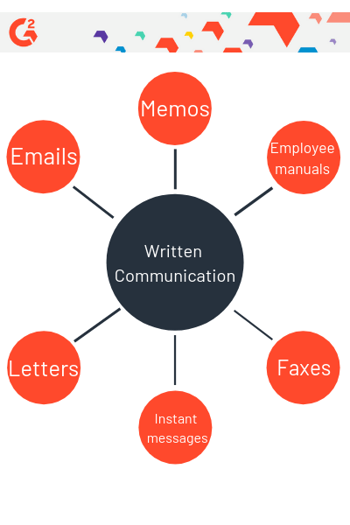
“I love you.” “Your paycheck has been delivered.”
Words we are all fond of hearing. Or even better, written words we are fond of reading once and then revisiting over and over. All thanks to written communication.
Already know the basics and looking for something specific? Jump ahead!
In the age of information, there is simply too much to remember. A simple solution is to write it all down.
Written communication is making use of the written word to deliver information. Anytime a person writes a message that will be sent along for someone else to read and interpret, they are using written communication.
A tale as old as Egyptian hieroglyphs, written communication has evolved in a lot of different directions. No matter where we go, we are surrounded by words. Notes from roommates saying the dishwasher is clean, expiration dates printed on food, and street signs telling us we made another wrong turn all give us worthwhile information that might ultimately alter our actions.
Of all communication channels, businesses rely the most on written communication. Emails, memos, company newsletters, meeting recaps, scribbled notes – the list goes on and on.

A great advantage of written communication is that the message can be referred back to at a later time, making it the best option for sending a lot of important information at once. And if there is one place you want to be on top of the latest information, it’s in the workplace.
Of all the types of communication, written is most reliable for discussing topics related to business. Let’s take a look at the three types of written communication, and when they should be used.
| TIP: Learn more about how you can apply communication theory to your writing. |
There are many different written communication channels in business. But no matter the channel, the content of the message sent is either transactional, instructional or informational.
Simply put, a transactional message is sent to get results. It can be a quick clarification, a request for a meeting, or asking for a favor. The whole point is to get a response from the person the message was sent to, or from the person with the best information.
Because the sender ultimately becomes the receiver when delivering transactional messages, they have the power to choose the channel that best fits their informational needs.
When sending a transactional message, it’s best to use an online form of written communication. The point of asking a question is to get a response, and preferably ASAP. Sending a written message on paper when a response is needed will leave you waiting without the information you need. Online written communication tools, such as instant messengers, are perfect for asking a brief question and getting the most timely response possible.
Informational written communication includes the sender delivering a message for the receiver’s benefit. Since this is less dependent on the receiver, there is no response needed. If the receiver has questions or concerns, that would bring the conversation back to transactional communication.
Informational messages can be sent to an individual or a group with the help of online and offline channels. A written memo posted in different locations around the office can address an entire group while also serving as a reminder of the information. An email, on the other hand, will likely pair the message with a notification or alert for the receiver, making it hard to miss.
Whichever channel you pick to send an informational message, make sure it will reach the audience before they must apply the information.
Instructional written communication gives receivers directions for a specific task. If the receiver is required to take action, it is important to make these messages detailed and easy to understand. Certain people may not know as much as others on the topic at hand, so including the basics is always necessary. The goal is to educate the audience about something they need to know and might have to apply later on.
When distributing instructional information, the format is more important than the method. Typically, instructions involve a step-by-step process. Using bullet points or numbering phrases can visually break down the directions and make the process easier to understand.
Now that we know the types of written communication, let's sharpen up that content.
When writing, you’ll need more than a pen and paper. These skills will make sure your writing is in tip-top shape.
While all types of written communication allow time to gather thoughts before sending a message, the use of that time varies.
Shooting a quick text to a friend simply requires typing the message and sending it, perhaps without a second thought. If the message is going to someone you have a more formal relationship with, you might want to have at least an idea of what you want to cover.
Writing emails, letters or memos is a different story. Ideas are written, then erased, then reworded, then erased again. This is mostly because the messages we send in emails, letters and memos tend to be more thoughtful and serious.
When deciding how much time to put into writing a message, consider the seriousness of the topic. Using written communication can seem impersonal at times, so take the extra time to make up for that.
Similar to verbal communication, the words we choose when writing affects the way the message is received.
The audience receiving the message should determine the words chosen. Sending an email full of lingo unique to your office will be confusing to a new employee. In situations where you are addressing a whole team, it is particularly important to explain jargon and industry terms for those with less experience.
One of the biggest misconceptions people generally have about writing is that the use of fancy words makes you seem more intelligent and well informed. But here’s the scoop: the true sign of knowledge on any topic is the ability to explain it in as few simple words as possible.
Keep it short, sweet, and informational.
Between screenshots and email archives, once you've shared those written words, it's hard to take them back. Save yourself any regrets by downloading the free communication tip sheet.
Formatting refers to the look and design of your written message. The size of the words, spacing, and paragraph layout can impact the reader’s experience. The wrong format can intimidate the reader, and dissuade their interest and comprehension of the message.
Put yourself in the shoes of the reader and think about how you would want that information to look and be delivered. Consider using lists, bullet points and breaking up paragraphs.
Editing written communication is crucial. It can be a pain, but the risk of a misspelled word or an embarrassing typo making you look unprofessional is not worth skipping it.
It is easy to recover from a mistake in a text or instant message. You can simply send another one correcting yourself. On the other more formal hand, written letters and emails should be reviewed more closely. An email correcting a mistake is hard to write, and once a written letter is sent, it’s not coming back.
Have someone else read over your work. A fresh set of eyes will always catch more grammar and spelling mistakes than just your own. Also, read it aloud. It’s easier to notice mistakes when sentences are vocalized.
Written communication is a simple, reliable and effective tool. The workplace has countless opportunities to communicate, and there are definitely times when writing is your best bet.
Need some more help crafting effective written communication for your business? Check out these newsletter examples for some tips!
Mary Clare Novak is a former Content Marketing Specialist at G2 based in Burlington, Vermont, where she is explored topics related to sales and customer relationship management. In her free time, you can find her doing a crossword puzzle, listening to cover bands, or eating fish tacos. (she/her/hers)
“Let me paint you a picture.”
 by Mary Clare Novak
by Mary Clare Novak
There was a time when communication was simple.
 by Mary Clare Novak
by Mary Clare Novak
Communication is related to every human activity.
 by Mary Clare Novak
by Mary Clare Novak
“Let me paint you a picture.”
 by Mary Clare Novak
by Mary Clare Novak
There was a time when communication was simple.
 by Mary Clare Novak
by Mary Clare Novak


